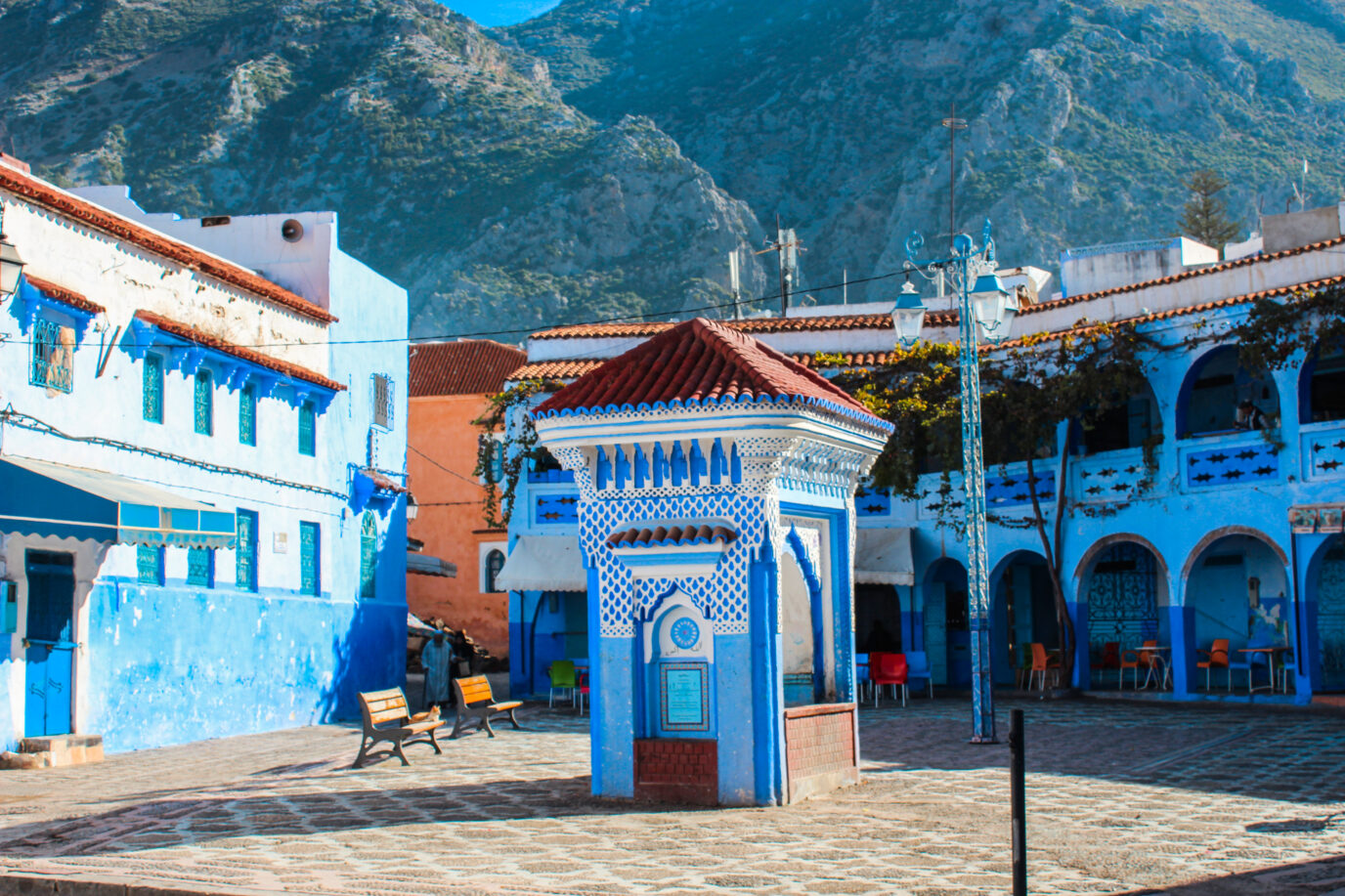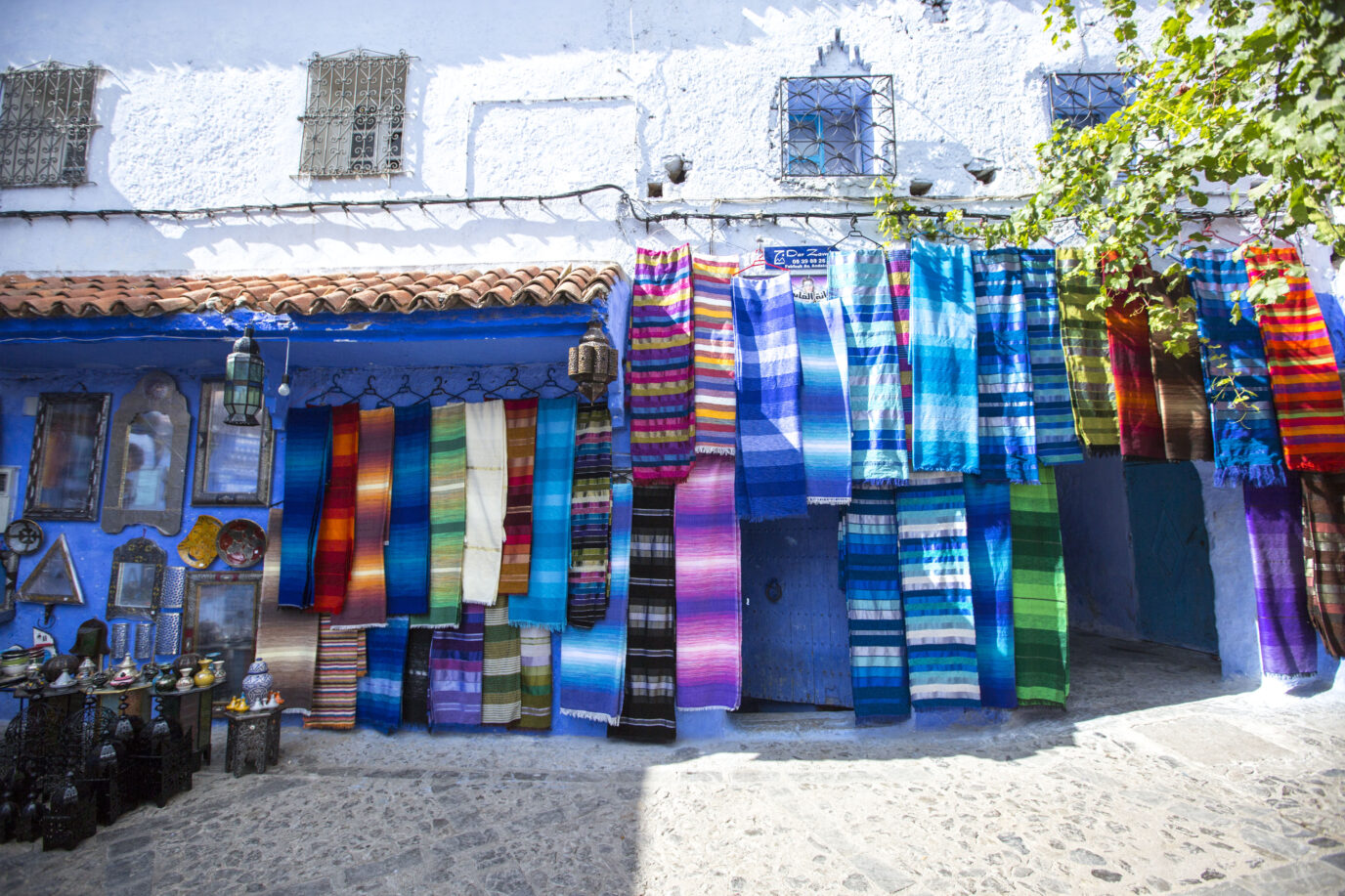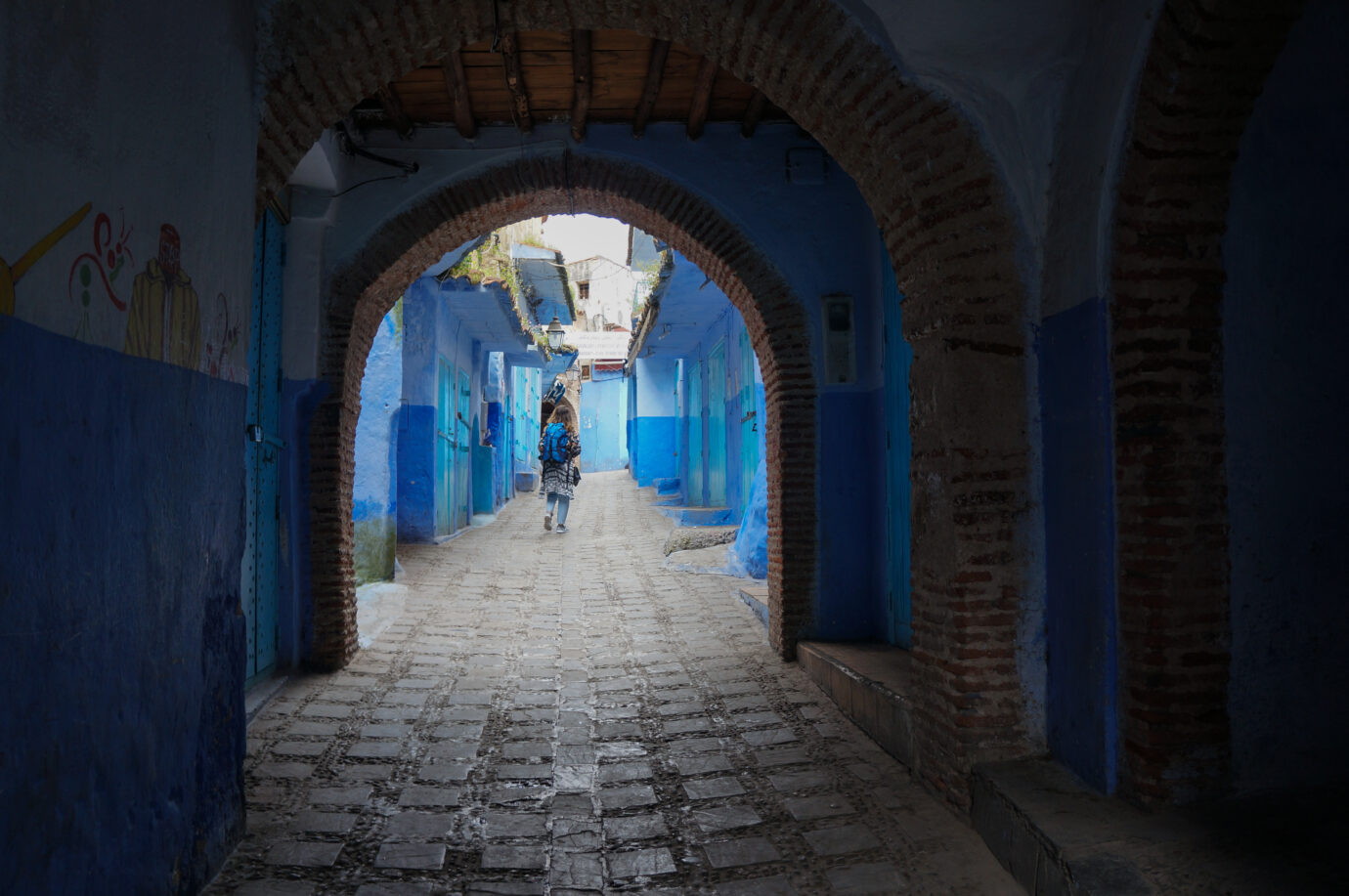Chefchaouen city is one of the most attractive cities in Morocco because of its crystal-clear light and its white and blue architecture. Due to this, it has become a popular destination for painters and artists. Chaouen, also known as Xauen or Chefchaouen, is popularly referred to as the ‘blue town of Morocco’ or ‘The Pearl of the North’. It boasts fascinating beauty with centuries-old blue and indigo doors and walls, painted in indigo and white and covered with layers of lime. This famous Mediterranean architectural design contributes to the city’s charm.
Chefchaouen
There is a story about Mulay Ali Ben Rachid loving Zhora, a girl from Vejer de la Frontera in Spain. When Muslims were kicked out of Andalusia, he moved to Morocco with her. In 1471, they built Chefchaouen on an old Amazigh town site. Because the city was surrounded by mountains, it was safe from invaders from other countries. This made it a holy place. It was home to Muslim and Jewish people who had to leave Andalusia. Because of this, it has small streets and houses painted white and blue. “Chefchaouen,” the name of the city between the Rif Mountains, comes from Amazigh words that mean “look at the horns,” which refer to the mountain peaks surrounding it.
Chefchaouen was closed to outsiders for centuries, keeping its ancient feel. 1912, Spanish forces took over the city as part of the Spanish Protectorate in northern Morocco. There were a lot of Sephardic Jews living there who spoke Judeo-Spanish. Spain left the area after World War II, but its impact is still felt today because many people still speak Spanish. The Rif Republic controlled the city for a short time and saw a lot of resistance against colonial power. Nowadays, Chefchaouen is a popular tourist destination. It also draws people from all over Morocco, especially the south.
Why Visit Chefchaouen?
As the “Blue Pearl of Morocco,” Chefchaouen is a beautiful mountain town known for its calm atmosphere, blue-painted streets, and long past. The city was founded in 1471 as a safe haven for Muslims and Jews from Andalusia. It still has the medieval beauty of Andalusian architecture and a laid-back atmosphere.
Chefchaouen is surrounded by the Rif Mountains and has beautiful scenery and hiking trails. It is a great place to get away from the busy towns of Morocco. Visitors can enjoy a one-of-a-kind shopping experience with handcrafted goods, tasty local food, and friendly service. Chefchaouen is a must-see for history buffs, nature lovers, and tourists looking for peace and quiet. Its architecture is a mix of Moroccan, Andalusian, and Spanish styles.
Top Attractions in Chefchaouen
Hassan II Avenue
The city’s main highway does not go through the Medina. At one of its ends is Mohammed V, which reminds us of the Spanish Protectorate due to its architecture. In this place, the market is held on Tuesdays and Thursdays. At the other end, we find Bab el Ain, the main entrance to the ancient city.
The souk
Many places of interest to see in Chaouen and northern Morocco are in the Medina of this city. It is an excellent place to get lost without feeling overwhelmed, as in larger cities like Fez or Marrakech. It is a quiet place, which houses more than half of the houses. Around its narrow streets is the souk, made up of all the handicraft shops. The traveler can observe the looms with which the artisans work and haggle to get a carpet at a reasonable price. Its many handicraft, leather, spices, and other shops make the walk a feast for all the senses. The variety of colors of the different products in the shops and bazaars contrasts with the dazzling blue-white of the houses. The mixture of voices and unknown sounds will guide you through the winding alleys until you inevitably reach the meeting and rest point.
Uta el-Hammam Square
It is the central square in Xauen where many bars are ready to feed the hungriest travelers. It is the ideal place to enjoy a mint tea or eat something in one of its establishments, observe the coming and going of the people, and see the beauty of the Great Mosque, built at the end of the 15th century Kasbah in front.
Kasbah
The Kasbah, which once protected the city from the Amazighs, hides a pleasant and peaceful Andalusian garden within its crenelated wall. In the basement of the Tower are the old cells of the prison where Abd el Krim was imprisoned in 1926. On your left is the ethnographic museum, one of the most exciting places to visit in Chaouen: in Morocco, few museums house such a rich collection of ancient weapons, with an art gallery, the Rif guardhouse, regional costumes, musical instruments, etc.
Makhzen Square
Home to the Parador Hotel and a large public parking lot is just a few more steps away, from which you may access an alley that leads to Chefchaouen’s most picturesque spots, Bab el-Ansar and the Ras el-Maa fountain. Under the relaxing sound of the water, you can go down next to the stream and see how the women do the laundry and how the hydraulic mills still work. This beautiful path takes us to the Rif Sebbanin, the laundry district, with the Plaza de Sebbanin and its 15th-century Mosque.
Ras el Maa
The visitor is also very attracted is Ras el Maa (“source of water”), a stream that rises from limestone rock. As is typical in the Andalusian culture, this watercourse is widely used for various activities: grain milling, washing, and irrigation ditches. So in a short tour, we can see the laundries (where women gather to wash, especially on weekends), the water mills that still grind cereal and chickpeas, and the ditches that irrigate the small riverside gardens.
Where to Stay in Chefchaouen
Dar echchaouen
This charming riad has beautiful views of the mountains, traditional Moroccan decor, and a calm setting close to the medina.
Lina Ryad & Spa
A high-class place to stay with beautiful rooms, an indoor pool, and a spa that is great for a peaceful getaway in the middle of Chefchaouen.
Casa Perleta
A cozy and tastefully decorated guesthouse known for its friendly staff, rooftop deck, and truly Moroccan atmosphere.
Puerta Azul
A stylish boutique hotel with plenty of big rooms, a tasty breakfast, and easy access to Chefchaouen’s blue streets.
Exploring the Culture of Chefchaouen
Local Culture: Chefchaouen’s peaceful mood comes from its Andalusian, Amazigh, and Moroccan roots. The friendly people, small souks, and easygoing daily life reflect this.
Traditional Food: Goat cheese, tagines, harira soup, and mint tea are just a few of the tasty dishes that the city offers.
Music: Chefchaouen’s music is a mix of Amazigh, Andalusian, and Gnawa styles with a spiritual and rich sound.
Traditional Clothes: People in the city wear djellabas, haiks, and other Amazigh items that show off their cultural roots.
Things to Do in Chefchaouen
Check out the Blue Medina
You can take beautiful pictures while walking along the blue-washed streets and enjoy the city’s unique charm.
Check out the Kasbah Museum
Learn about Chefchaouen’s past and take the view from the fortress in the middle of the medina.
Take a walk to the Spanish Mosque
This mosque is on top of a hill and has fantastic views of the whole city, especially at sunset.
Laze around at Ras El Maa
A quiet place where people meet near a freshwater spring, great for taking a break and enjoying nature.
Buy handicrafts made in the area
You can find rugs, knitted blankets, pottery, and Amazigh jewelry made by local artists in the souks.
Check out Akchour Waterfalls
Outside of the city, there is a beautiful walk with waterfalls and natural pools that thrill seekers will love.
Best Time to Visit Chefchaouen
The best time to visit Chefchaouen is from March to May when the flowers bloom and the weather is warm. The blue streets look incredibly bright. Now is a great time to walk through the medina and go hiking in the nearby Rif Mountains.
The fall, from September to November, is also a great time to go because the weather is nice and there aren’t as many people. The cool breeze and bright sunlight make walking around the city and on nearby nature trails a pleasure.
Even though it can get hot, Chefchaouen stays more remarkable than many other Moroccan towns in the summer (June to August). This is the busiest time for tourists, so expect more people, but it’s still a great time to enjoy the lively scene and cafés outside.
Winter, from December to February, is the least busy time of year. It is cooler and rains sometimes. Even though it’s not the best time to go climbing, the medina is less crowded and more peaceful now.
How to Get to Chefchaouen
There are many ways to get to Chefchaouen, which is in the northern part of Morocco.
By Plane
Tanier Ibn Battouta Airport (TNG) is the closest airport. It’s about a two-hour drive from Chefchaouen. Fes-Saïs Airport (FEZ) is another choice. It’s about 4 hours by car. You can rent a car or take a cab from either airport to get to Chefchaouen.
By Train
You can’t take a train straight to Chefchaouen. u can, however, take the train to Tangier or Fes and then a cab or bus to Chefchaouen. The train ride from Blanca to Tangier takes about 4–5 hours. F, and forms, it takes about 4 hours.
By Bus
Taking the bus is an easy way to get to Chefchaouen. From Tangier, Fes, and Marrakech, you can take a bus to Chefchaouen with several companies, such as CTM and Supratours. Depending on where you live, the bus ride usually takes two to four hours.
By Car
Another choice is to rent a car, which is excellent for people who want to see more of the area. By car, Tangier (2 hours), Fes (4 hours), and Marrakech (7-8 hours) are all easy to get to Chefchaouen. The drive has beautiful views of the Rif Mountains.
Frequently Asked Questions
Why is Chefchaouen called the Blue City?
Chefchaouen, also known as the “Blue City,” is known for its beautiful blue houses. There are different ideas about where this color came from. Some say it was used to keep mosquitoes away, brought by Jewish refugees in the 1930s. It has religious meanings or is pushed by the town’s founder, Moulay Ali Ben Moussa, because it looks nice. Chefchaouen is a must-see for tourists and photographers, thanks to its beautiful blue streets, winding alleys, and mountain backdrop.
Is Chefchaouen worth a visit?
You must go to Chefchaouen, famous for its beautiful blue-painted Medina and unique atmosphere. Its narrow streets are great for walking around and exploring, and many shops and bars exist. The old Kasbah, now a museum, shows the town’s history, which is very rich. People who love being outside can go hiking in the Rif Mountains, where the trails offer beautiful views. Moroccan food is delicious, with dishes like tagine, couscous, harira soup, and traditional hammams, which are a great way to rest. Chefchaouen has something for every visitor because it combines history, culture, and nature.




